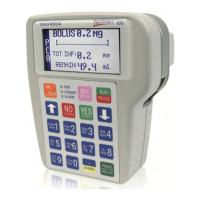What to do if value entered is greater than the value in the bag volume field on Moog CURLIN INFUSION PainSmart?
- SshannonwilkinsSep 6, 2025
Recheck data entry.

What to do if value entered is greater than the value in the bag volume field on Moog CURLIN INFUSION PainSmart?
Recheck data entry.
| Manufacturer | Moog |
|---|---|
| Model | CURLIN INFUSION PainSmart |
| Indication | Pain Management |
| Delivery Method | Continuous |
| Infusion Modes | Continuous |
| Power Source | Battery |
| Volumetric Accuracy | ±5% |
| Flow Rate Range | 0.1 mL/hr |
| Volume Range | 0.1 mL to 9999 mL |
| Occlusion Pressure Settings | Adjustable |
| Alarms | Occlusion, low battery, system error |
| Display | LCD |
Details the unique features like accuracy, portability, and specialized functions of the pump.
Outlines critical safety information, potential hazards, and important advisories for pump operation.
Provides definitions for abbreviations used throughout the user manual.
Identifies and describes the key components and physical features of the infusion pump.
Details the components and functionality of the disposable administration sets.
Guides users on selecting and properly installing the infusion pump's administration set.
Explains the function and behavior of the pump's upstream occlusion alarm.
Provides instructions for replacing the pump's C-cell batteries and accessing the compartment.
Describes options for powering the pump, including C-cell batteries, battery pack, and AC adaptor.
Details the use and connection of the AC adaptor for powering and charging the pump.
Explains the function and connection of the remote bolus cord for patient-controlled analgesia.
Details the purpose and operation of each key on the pump's keypad.
Explains how to access and interpret information displayed via the IOD feature.
Describes pump configurations for maximum basal rate, clinician, and load dose limits.
Explains the pump's lock level settings and their impact on user access.
Details the meaning of LED status lights and the pump's audible alarm system.
Describes the structure and elements of the pump's display screen.
Explains the different types of screens encountered during pump programming.
Covers using help, starting the pump, and interpreting status screens like power and maintenance.
Details the process of entering access codes and navigating the BioMed Setup menu.
Describes how to access the patient history log and clear pump data.
Explains prescription settings, units, and available administration routes.
Guides on setting medication limitations (medLMTS™) for PCA therapies.
Details options available from the Run Options screen and the pump priming process.
Covers pump customization options like lock settings, clinician dose, and totals tracking.
Explains how to start an infusion and pause/interrupt an ongoing therapy.
Guides on resuming interrupted therapies and repeating previous prescriptions.
Introduces the different types of alerts, alarms, and error codes encountered with the pump.
Lists and explains common alarm conditions and their resolutions.
Provides a comprehensive list of error codes, probable causes, and corrective actions.
Describes the pole clamps used for mounting the pump or safety shells.
Explains the function and use of the remote bolus cord for PCA therapy.
Details the protective, lockable cases for securing the pump and accessories.
Describes the holster for securely mounting the pump onto an IV pole.
Lists available protective covers for the pump's keypad.
Provides guidelines and prohibited methods for cleaning the infusion pump and its accessories.
Outlines recommended conditions for transporting, storing, and operating the pump.
Details routine maintenance recommendations and the pump's limited warranty terms.
Steps for inspecting and cleaning the pump before use with a new patient.
Procedures for performing volumetric accuracy checks on the infusion pump.
Steps for verifying the proper function of the pump's safety systems.
Lists physical dimensions, materials, and operating environment specifications.
Details battery life, display capabilities, flow rates, and bolus parameters.
Specifies detection times for occlusion alarms under various conditions.
Explains how clinicians access secured functions using access codes.
Lists catalog numbers and configurations for different pump models.